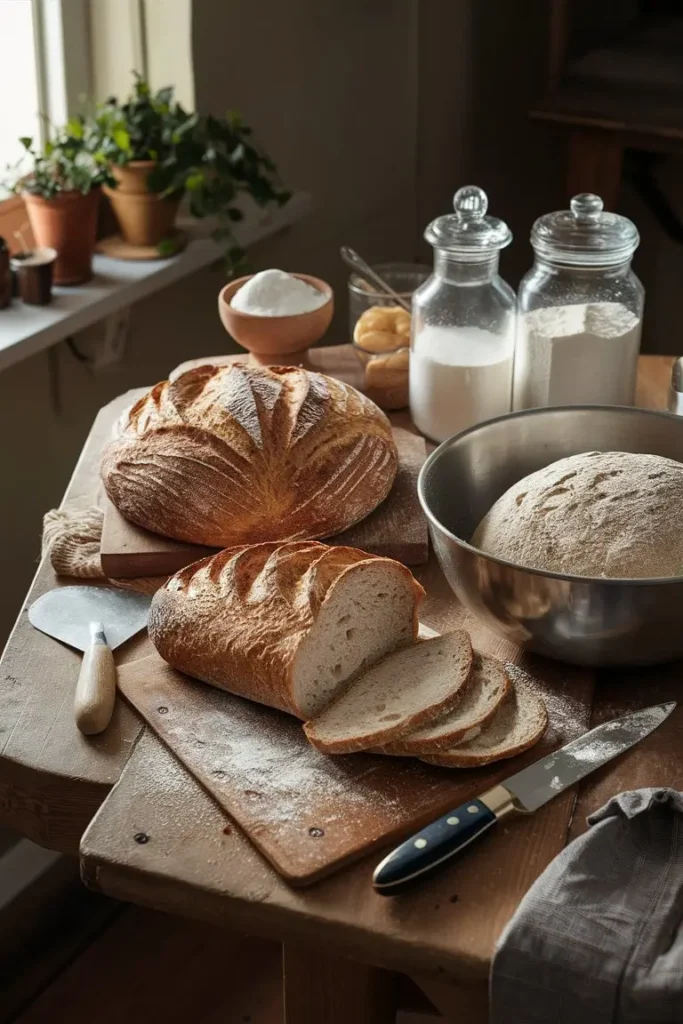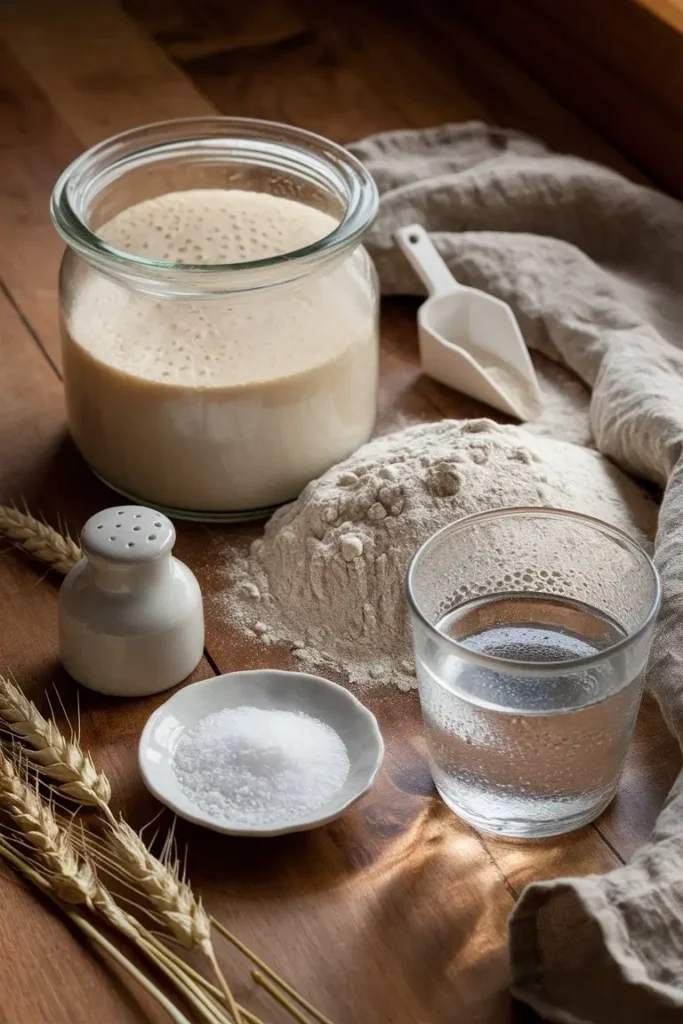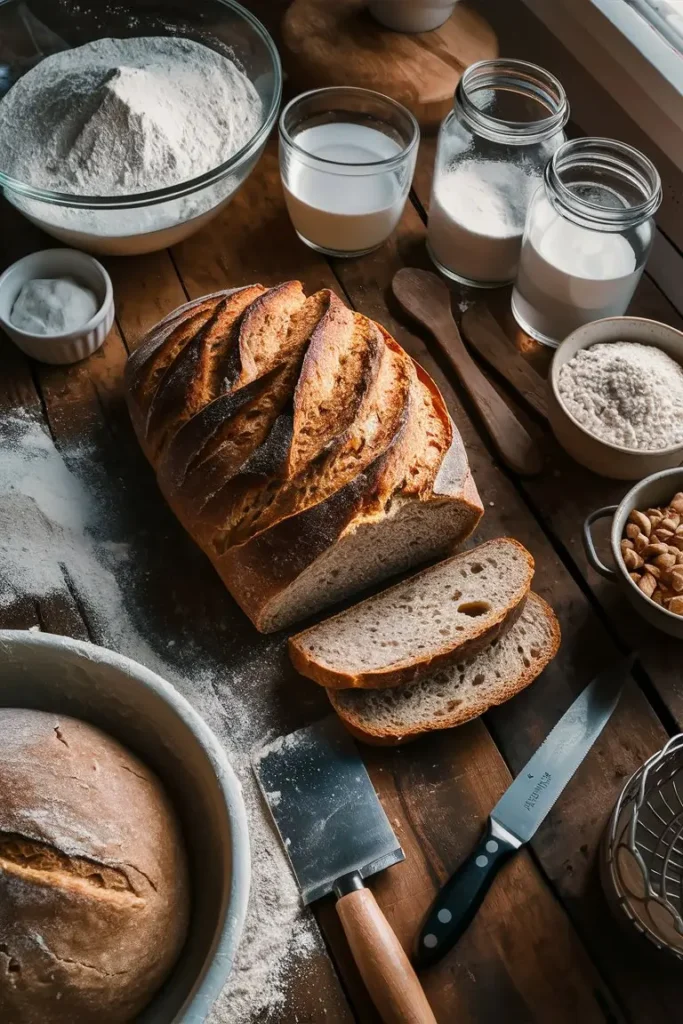Sourdough Bread Recipe: 8 Secrets for Amazing Homemade Bread
Table of Contents
Introduction: Sourdough Bread Recipe
Have you ever wondered why some people can make perfectly crusty and flavorful sourdough bread while others struggle with flat, dense loaves? What’s the secret ingredient that transforms simple flour, water, and salt into a culinary masterpiece? If you’re curious about how to elevate your bread-making skills, you’re in the right place! In this blog post, we’re going to uncover 8 secrets that will help you master the art of sourdough bread at home with our incredible Sourdough Bread Recipe.

Overview:
This Sourdough Bread Recipe is special because it’s not just about following steps; it’s about understanding the science and love behind baking. With a little patience and practice, you can create a bread that tastes like it came straight from a bakery! This recipe takes about 24 hours from start to finish, but most of that time is for letting the dough rise. Don’t worry; the actual hands-on time is quite short! The difficulty level is easy to moderate, making it a great choice for both beginners and experienced bakers looking to improve their skills.
Essential Ingredients:
To make the best sourdough bread, you need just a few essential ingredients:
- Bread Flour: Provides structure and strength to your bread. You can use all-purpose flour, but bread flour gives better results.
- Water: Hydrates the flour and helps develop gluten. Use filtered water for the best taste.
- Salt: Enhances flavor and controls fermentation. Sea salt or kosher salt works well.
- Sourdough Starter: This is the magic ingredient! A healthy starter is crucial for leavening the bread and giving it that unique sour taste.

Substitutions and Variations:
- Flour: You can experiment with whole wheat flour or rye flour for different flavors and textures. Just be aware that it may change the water content slightly.
- Water: If you want to add flavor, try using beer or milk instead of water!
- Salt: If you’re on a low-sodium diet, you can reduce the salt, but this may impact the bread’s flavor and texture.
Step-by-Step Instructions:
1. Prepare Your Sourdough Starter
- Make sure your sourdough starter is active. Feed it 4-8 hours before you start baking. It should be bubbly and double in size.
2. Mix the Dough
- In a large bowl, combine 500g of bread flour and 350g of water. Mix until there are no dry spots. This is called the autolyse step and helps with gluten formation.
- Let it rest for 30 minutes.
3. Add Salt and Starter
- After resting, sprinkle 10g of salt over the dough. Add 100g of your active sourdough starter.
- Mix well using your hands. Pinch and fold the dough until the salt and starter are fully incorporated.
4. Bulk Fermentation
- Cover the bowl with a damp cloth and let it sit at room temperature for 4-6 hours. During this time, perform a series of stretch and folds every 30 minutes for the first 2 hours. This strengthens the dough.
5. Shape the Dough
- After the bulk fermentation, turn the dough out onto a lightly floured surface. Gently shape it into a round ball by folding the edges into the center.
- Let it rest for 20 minutes, then shape it again into a tighter ball.
6. Second Rise
- Place the shaped dough into a floured proofing basket or bowl. Cover it and let it rise for another 2-4 hours at room temperature, or overnight in the fridge for a cold rise.
7. Preheat the Oven
- About 30 minutes before baking, preheat your oven to 450°F (230°C) with a Dutch oven inside. This creates the perfect steaming environment for your bread.
8. Bake the Bread
- Carefully remove the hot Dutch oven and place your dough inside. Cover it with the lid and bake for 30 minutes. Then, remove the lid and bake for another 15-20 minutes until golden brown.
Assembly:
Once your bread is out of the oven, let it cool on a wire rack for at least 1 hour before slicing. This helps the interior finish setting up. For presentation, serve your sourdough bread with a spread of butter or olive oil, or slice it for sandwiches.
Storage and Make-Ahead Tips:
- Storage: Keep your sourdough bread in a paper bag at room temperature for up to 3 days. For longer storage, slice the bread and freeze it. Just toast the slices when you’re ready to enjoy them.
- Make-Ahead: You can prepare your dough the night before and let it rise in the fridge. This not only saves time but also enhances the flavor.
Recipe Variations:
- Herb Sourdough: Add chopped fresh herbs like rosemary or thyme to the dough during mixing for a fragrant twist.
- Cheese Sourdough: Incorporate shredded cheese into the dough before the final rise for a cheesy delight.
- Fruit and Nut Sourdough: Mix in dried fruits like cranberries or nuts like walnuts for added texture and flavor.

Conclusion:
Baking sourdough bread at home is a rewarding experience, and with these 8 secrets from our Sourdough Bread Recipe, you’re well on your way to creating bakery-quality bread right in your kitchen. Don’t be afraid to experiment with flavors and techniques. Enjoy the process, have fun, and most importantly, enjoy your delicious homemade sourdough bread!
FAQs:
1. How do I know my sourdough starter is ready?
Your sourdough starter is ready when it has doubled in size, is bubbly, and has a pleasant, slightly tangy smell.
2. What if my dough is too sticky?
If your dough is too sticky, try adding a little more flour during the mixing process. However, be careful not to add too much, as it can affect the final texture.
3. Can I make sourdough bread without a Dutch oven?
Yes! You can use a baking stone or a heavy baking sheet. Just create steam by adding a pan of water at the bottom of the oven while baking.
4. How do I store leftover sourdough bread?
Wrap it in a cotton cloth and keep it at room temperature for a few days. For longer storage, slice and freeze it.
5. What are the health benefits of sourdough bread Recipe?
Sourdough bread is easier to digest, has a lower glycemic index, and is rich in nutrients and probiotics, making it a healthier choice compared to regular bread.Now, go ahead and enjoy the wonderful world of sourdough baking!
Best Amazon Picks
- Sourdough Starter Kit
- Artisan Bread Making Kit
- Cuisinart Bread Maker Machine
- Honest Amish – Classic Beard Oil – 2 Ounce
